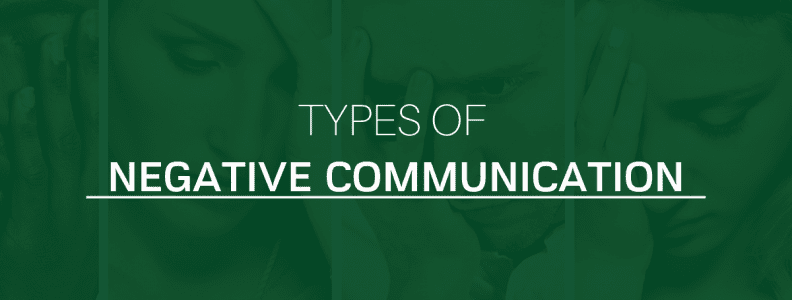HOW TO COMMUNICATE TO HEAL, NOT HURT PART TWO: NEGATIVE COMMUNICATION
In communication, as in most things human, “we have met the enemy, and it is us.” Negative communication patterns in addiction abound, and the same is true everywhere we look, every day. Some people have unknowingly developed maladaptive ways of communicating. Some people deliberately choose to hurt others and seek personal gain by communicating in deceitful and misleading ways. Fortunately, though, most of us want better, healthier relationships and more positive outcomes. Understanding common negative communication patterns is a good place to start. There are three main types of negative communication: passive, aggressive and passive aggressive. Few people exhibit these patterns in the extreme – those who do have significant psychopathology. But chances are, you and others around you occasionally slip into some negative behaviours. Developing consciousness in our communication behaviour is essential to improving it.
EXAMPLES OF PASSIVE COMMUNICATION
Carol has researched treatment facilities for her son Tony. She tells him about one nearby where clients can come and go and have visitors. She likes this option because it meets her needs – she is afraid of losing him and wants to be able to stay closely connected even when he is in treatment. Tony really wants to get help but knows he won’t succeed there because he’ll be too close to the triggers and influences that keep him bound in addiction. Yet he does not say so. He listens quietly then complies with his mom’s choice. Tony is a passive communicator. Here’s another example. Your new boyfriend wants to go see a popular new movie with a lot of violence. You really hate movies with violence. As a child you witnessed violence at home. Movies like this make you feel anxious and sometimes even nauseous. But you say nothing of this. Instead you say you’ve heard the movie is really good and you agree to go.
 CHARACTERISTICS OF PASSIVE COMMUNICATION
CHARACTERISTICS OF PASSIVE COMMUNICATION
- We don’t express our own needs (You matter, I don’t)
- We want to avoid conflict, seek approval
- Others are important and we are unimportant
- We are anxious and have low self-esteem
- We do not exhibit confidence
- We use phrases like “I don’t care” or “whatever” or just remain silent – to placate
- We don’t make good eye contact and we speak quietly
EXAMPLES OF AGGRESSIVE COMMUNICATION
Carol uses aggressive communication to tell her son Tony what she thinks about his addiction: “All you do is get drunk, get high, come home wasted! You are wasting your life and you don’t give a &*(% about this family! You’ve never given a damn about us. Either you…or I’ll…” Another example. John is an accountant whose error has just cost his company several thousand dollars. His boss slams the office door and yells: “John, you *%*-ing imbecile. What is your problem? You are a complete idiot! You just cost this company 9 grand and you’ve made ME look like a fool. Little Johnny, I’ll bet you can’t tie your own shoes, for ^&% sake…”
CHARACTERISTICS OF AGGRESSIVE COMMUNICATION
- We disregard the rights of others around us (I matter, you don’t.)
- We don’t exhibit concern for others
- We are willing to reach our goals at the expense of others, willing to hurt others
- Intimidation is part of this style
- Loud
- Personal attacks, name calling
- We say “you” judgmentally – a lot
- We exhibit confidence – too much
Sigh. It’s not pretty, is it. Neither passive nor aggressive communication is healthy or effective. We’ll cover the third type, passive aggressive, in the next blog. In our experience it is more common, perhaps because it is more veiled and nuanced. We cannot leave you on this negative note! Remember that we’ll focus on aspects of healthy, assertive communication soon! In the meantime, we offer two constructive ideas.
- Consider if and how you ever communicate in passive or aggressive ways. Being conscious of our own communication behavior is important.
- Here is a teaser on how assertive communication would be helpful in these scenarios. There is lots more to come later on how to communicate assertively!
If you recognize passive communication in someone:
- Ask questions that encourage them to contribute ideas and opinions.
- Take time to discuss their point of view – express interest in it.
- Listen carefully before continuing the conversation.
- Encourage their involvement in decision-making.
If you recognize aggressive communication in someone:
- Your instinct will be fight or flight but instead, exhibit calm confidence and self-control.
- Listen without judgment or interruption.
- Acknowledge what they are feeling. Your goal is to help them regain control. It’s useless to discuss or attempt reason at this time. They are likely incapable of it. Your only goal is to help calm things.
- Use open body language with a neutral facial expression.
- No matter what, be safe. If you think there is any possibility of physical harm, have a way out.
By June Sobocinski, M.A. Applied Communication

